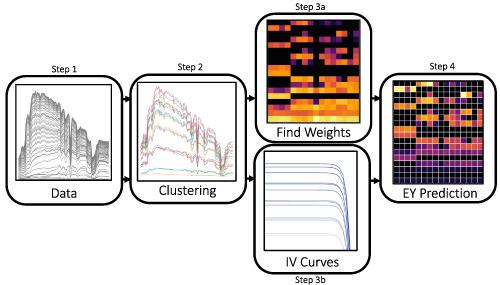当前位置:
X-MOL 学术
›
Prog. Photovoltaics
›
论文详情
Our official English website, www.x-mol.net, welcomes your
feedback! (Note: you will need to create a separate account there.)
Representative identification of spectra and environments (RISE) using k‐means
Progress in Photovoltaics ( IF 8.0 ) Pub Date : 2020-12-09 , DOI: 10.1002/pip.3358 Erin E. Looney 1 , Zhe Liu 1 , Andrej Classen 2 , Haohui Liu 3 , Nicholas Riedel 4 , Marília Braga 5 , Pradeep Balaji 6 , André Augusto 6 , Tonio Buonassisi 1 , Ian Marius Peters 2
Progress in Photovoltaics ( IF 8.0 ) Pub Date : 2020-12-09 , DOI: 10.1002/pip.3358 Erin E. Looney 1 , Zhe Liu 1 , Andrej Classen 2 , Haohui Liu 3 , Nicholas Riedel 4 , Marília Braga 5 , Pradeep Balaji 6 , André Augusto 6 , Tonio Buonassisi 1 , Ian Marius Peters 2
Affiliation

|
Spectral differences affect solar cell performance, an effect that is especially visible when comparing different solar cell technologies. To reproduce the impact of varying spectra on solar cell performance in the lab, a unique classification of spectra is needed, which is currently missing in literature. The most commonly used classification, average photon energy (APE), is not unique, and a single APE value may represent various spectra depending on location. In this work, we propose a classification method based on an iterative use of the k‐means clustering algorithm. We call this method RISE (Representative Identification of Spectra and the Environment). We define a set of 18 spectra using RISE and reproduce the spectral impact on energy yield for various solar cell technologies and locations. We explore effects on yield for commercially available solar cell technologies (Si and CdTe) in four locations: Singapore (fully humid equatorial climate), Colorado (cold arid), Brazil (warm, humid, and subtropical), and Denmark (fully humid warm temperature). We then reduce our findings to practice by implementing the spectrum set into an LED current–voltage (IV) tester. We verify our performance predictions using our set of representative spectra to reproduce energy yield differences between Si solar cells and CdTe solar cells with an average error of less than 1.5 ± 0.5% as compared to over 5% when using standard testing conditions.
中文翻译:

使用k均值的光谱和环境(RISE)的代表性识别
光谱差异会影响太阳能电池的性能,这种效果在比较不同的太阳能电池技术时尤其明显。为了在实验室中再现变化的光谱对太阳能电池性能的影响,需要对光谱进行独特的分类,这在文献中目前是缺失的。最常用的分类是平均光子能量(APE)并非唯一,并且单个APE值可能会根据位置表示各种光谱。在这项工作中,我们提出了一种基于k-means聚类算法迭代使用的分类方法。我们称此方法为RISE(光谱和环境的代表性识别)。我们使用RISE定义了一组18个光谱,并再现了光谱对各种太阳能电池技术和位置对能量产量的影响。我们在以下四个地点探索了商用太阳能电池技术(Si和CdTe)对产量的影响:新加坡(赤道完全湿润),科罗拉多州(冷干旱),巴西(温暖,潮湿和亚热带)和丹麦(完全潮湿温暖温度)。然后,我们通过将光谱集应用到LED电流-电压(IV)测试仪中来简化我们的发现,以付诸实践。我们使用一组有代表性的光谱来验证我们的性能预测,以再现Si太阳能电池和CdTe太阳能电池之间的能量产量差异,其平均误差小于 然后,我们通过将光谱集应用到LED电流-电压(IV)测试仪中来简化我们的发现,以付诸实践。我们使用一组代表性光谱来验证我们的性能预测,以再现Si太阳能电池和CdTe太阳能电池之间的能量产率差异,其平均误差小于 然后,我们通过将光谱集应用到LED电流-电压(IV)测试仪中来简化我们的发现,以付诸实践。我们使用一组有代表性的光谱来验证我们的性能预测,以再现Si太阳能电池和CdTe太阳能电池之间的能量产量差异,其平均误差小于1.5±0.5%,而使用标准测试条件时则超过5%。
更新日期:2021-01-29
中文翻译:

使用k均值的光谱和环境(RISE)的代表性识别
光谱差异会影响太阳能电池的性能,这种效果在比较不同的太阳能电池技术时尤其明显。为了在实验室中再现变化的光谱对太阳能电池性能的影响,需要对光谱进行独特的分类,这在文献中目前是缺失的。最常用的分类是平均光子能量(APE)并非唯一,并且单个APE值可能会根据位置表示各种光谱。在这项工作中,我们提出了一种基于k-means聚类算法迭代使用的分类方法。我们称此方法为RISE(光谱和环境的代表性识别)。我们使用RISE定义了一组18个光谱,并再现了光谱对各种太阳能电池技术和位置对能量产量的影响。我们在以下四个地点探索了商用太阳能电池技术(Si和CdTe)对产量的影响:新加坡(赤道完全湿润),科罗拉多州(冷干旱),巴西(温暖,潮湿和亚热带)和丹麦(完全潮湿温暖温度)。然后,我们通过将光谱集应用到LED电流-电压(IV)测试仪中来简化我们的发现,以付诸实践。我们使用一组有代表性的光谱来验证我们的性能预测,以再现Si太阳能电池和CdTe太阳能电池之间的能量产量差异,其平均误差小于 然后,我们通过将光谱集应用到LED电流-电压(IV)测试仪中来简化我们的发现,以付诸实践。我们使用一组代表性光谱来验证我们的性能预测,以再现Si太阳能电池和CdTe太阳能电池之间的能量产率差异,其平均误差小于 然后,我们通过将光谱集应用到LED电流-电压(IV)测试仪中来简化我们的发现,以付诸实践。我们使用一组有代表性的光谱来验证我们的性能预测,以再现Si太阳能电池和CdTe太阳能电池之间的能量产量差异,其平均误差小于1.5±0.5%,而使用标准测试条件时则超过5%。











































 京公网安备 11010802027423号
京公网安备 11010802027423号